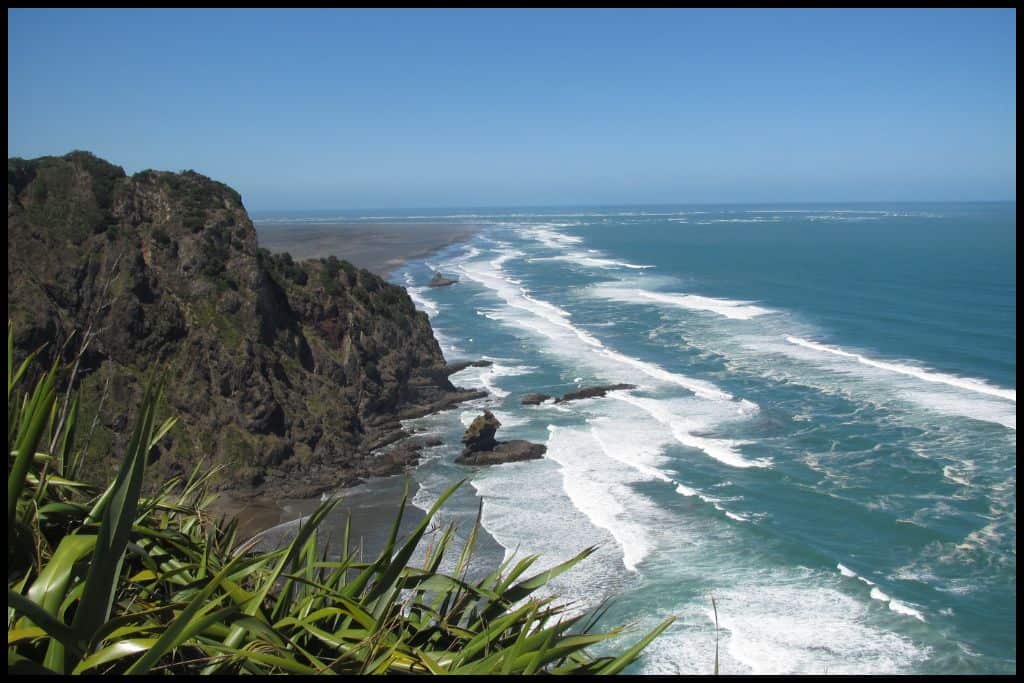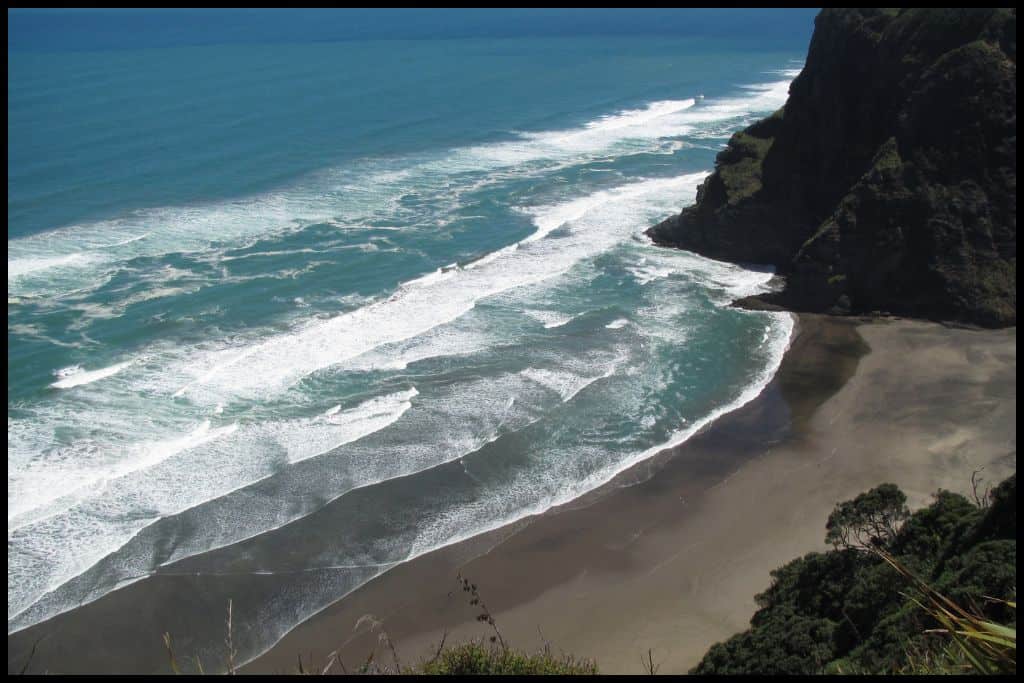Where To Find The Best 21 New Zealand Black Sand Beaches
21 Beautiful Black Sand Beaches in New Zealand
We all have pictures in our head of beautiful, tranquil beaches, with white sand and turquoise water, but how many of you have experienced the beauty of a beach where the sand is .. black? Black sand beaches have a different kind of beauty, rugged and wild, and only places with volcanic activity tend to have them!
New Zealand has several black sand beaches, some more famous, and some lesser known. Below I have grouped them by region, so no matter where your New Zealand travels take you, you can make sure you detour to one of these stunning spots.
Black Sand Beaches in Auckland:
Auckland has the most black sand beaches out of anywhere else in New Zealand, its three most popular being Te Henga (Bethells Beach), Piha, and Muriwai. Each offers something different, and it’s worth checking out more than one!
1. Piha
Piha is our best known black sand beach, brought to fame by the TV show Piha Rescue, a spinoff of Bondi Rescue. It’s best known for its rips and currents, but don’t let that put you off! The lifeguards are excellent at what they do, and with them there to keep you safe, visitors can freely enjoy what are, quite frankly, some spectacular waves for jumping around in and boogie-boarding.

Lion Rock (or Te Piha in Māori) divides the beach into North Piha and South Piha, and if you were to walk along the beach heading south, you would approach Camel Rock.
Camel Rock is the gateway to a tiny little bay around the corner named Puaotetai Bay, and this can only be accessed at low tide. You’ll be able to see The Keyhole, which is a hole through the middle of Camel Rock, and then to the left you’ll find The Gap – this little bay created between Taitomo Island and the cliffs. Time it right, and the crashing waves will have created a small swimming hole in the sand, named the Blue Pool. (Just be sure to return down the beach well before the tide comes back in and the water cuts you off.)

It’s also worth seeing Kitekite Falls, which are 1 kilometre (0.6 miles) from the beach. They are 40 metres tall and you can swim at the bottom – or at the top, if you make the ascent. The highest pool has views all the way down to the bottom and you can swim up and peer over the edge, or get an insta-worthy shot!

2. Muriwai
Muriwai is an hour north of Piha by car, because you have to head inland a bit to drive up there. It is also lifeguarded and makes for fantastic swimming and surfing.
Muriwai is also home to a gannet colony (at Ōtakamiro Point). Gannets are seabirds predominantly found in our part of the world, and if you take a walk up the Maukatia Gannet Track (start at the carpark), you’ll find up to 2,000 birds nesting and making a racket on the clifftop. The track will get you up high enough to look down on them, so it is quite a sight. (But ensure you come between August and March to see them!)
At the time of writing (November 2024), the track up there is still closed after 2022’s cyclone, so make sure you check the status before you make a special trip out there.
There’s also a blowhole to see, where the waves push all the water up in a geyser-like display at high tide.
The Te Henga Walkway will take you south to Te Henga (Bethells Beach) if you are up for a 3 hour walk. It is 10 kilometres (6.2 miles), and it is easier to walk the track south (Muriwai to Te Henga) than it is to walk north (Te Henga to Muriwai), because of a steep uphill climb, going north.



3. Māori Bay
Follow the track from the gannet colony (or jump back in the car and head down the road a couple of minutes more) and you’ll find yourself at Māori Bay (Maukatia). This is where my husband proposed to me! It’s rugged, it’s wild, and it’s beautiful.
The water is just for surfers, as it is not lifeguarded and the currents can be quite strong, but if you make it for sunset, there’s a large (really large!) boulder in the middle of the beach that makes the perfect spot to watch the sun go down (or propose! 😉 ).



4. Te Henga (Bethells Beach)
Situated south of Muriwai, but north of Piha, is Te Henga (Bethells Beach). Bethells Beach is special because there are lots of sand dunes here, and even a lake (Lake Wainamu) within them! The Lake Wainamu Track circles the lake, and will take you an hour to walk.
It’s worth spending a day out at Te Henga, exploring. There is a large cave on the beach (Bethells Cave), which is about 30 metres deep, and a walkway that allows you to walk from Bethells Beach north to Muriwai, on the Te Henga Walkway. It’s a 10 kilometre (6.2 mile) return trip and will take you 3 hours.
Bethells is lifeguarded, so you can safely enjoy swimming in the surf.


5. O’Neill Bay
Taking the Te Henga Walkway north toward Muriwai, you’ll soon come across O’Neill Bay, which is the next bay up from Bethells Beach. To get there, head north down the beach and follow the signs up to the right before you reach the cliffs. The rest is signposted.
The water is a lot calmer on the O’Neill Bay side, but do be very careful when swimming, because this stretch of coastline is not referred to as ‘the Wild West’ for nothing, and the currents and tides remain strong. You are likely to be able to enjoy calmer water though, if being buffeted around by waves is not your ideal swimming (Wouldn’t recommend it though..)
6. Anawhata
South of Te Henga (Bethells Beach), but north of Piha, lies Anawhata Beach. It is extra special – you can only come by foot! The closest you’ll get by car is down Anawhata Road but you will still need to wind your way down to the beach for 20 minutes, so come prepared.
You can also walk there from North Piha beach, on the Anawhata Coast Track (however, currently there are some track closures in the regional park, and this is one of them – updated 2024). You’ll find Anawhata Beach either empty or very quiet, so it is a good spot to sit and enjoy the surroundings, or take a wander up the Anawhata Stream, which winds away from the beach.
Anawhata is not lifeguarded so I really would save your swimming for one of the lifeguarded beaches. It can just be so dangerous if you get into trouble. Instead, just enjoy the beauty of the glittering black sand and huge cliffs – especially if you’re lucky enough to have the beach to yourself!
7. Karekare
Karekare Beach, is, along with all of those listed above, part of the wider Waitākere Ranges Regional Park, 16,000+ hectares of bush, rainforest, and black sand beaches. There are so many awesome walking trails here, but many are currently closed (written 2024) while the Department of Conservation gets kāuri dieback disease under control, so always check for any current closure alerts online.
Karekare is lifeguarded, so it is important to swim here only when it is being patrolled, for your own safety.
There is a stream to paddle in (Karekare Stream), and sand dunes to slide down.
Visit Karekare to see the waterfall: it’s a 5 minute walk from the carpark (650 metres), 30 metres tall, and just stunning. To get to the top of the waterfall, there is a track named Taraire Track, which a 30 minute walk, but this is currently closed at the time of writing.
Near the main waterfall is a smaller cascade falling over some black rocks into Opal Pool (the Opal Pool Stream Cascade).



8. Whātipu
You’ll find Whātipu Beach south of Karekare Beach, the southernmost black sand beach in the Waitākere Ranges. Walking between Karekare Beach and Whātipu Beach is possible and will take you 3 hours (the Karekare-Whātipu Loop). It’s just over 10 kilometres one way (6.2 miles).

There is a whole network of walking trails in the area and it is worth doing your research about what options you have and to check for any current closure alerts.
Whātipu is an excellent spot to collect some mussels, as there are plenty on the rocks.
It is also home to Giant Cave, which is a 30 minute walk there from the carpark, and a 30 minute walk back. The Whātipu Caves Track has a few caves along it, but the biggest, which is Giant Cave, is the most impressive. Believe it or not, in the 1900’s, they would illuminate it and use it as a ballroom!
A 20 minute drive away is Karamatura Falls, a very cold (!) but very pretty spot to swim, if you’re up for the 3.5 kilometre (2.2 mile) moderately challenging track. They have also just re-opened the Ōmanawanui Track; you leave from the beach carpark and after 30 minutes of staircases, you will get the most tremendous views of Whātipu and back across the Manukau Harbour toward Āwhitu Peninsula.
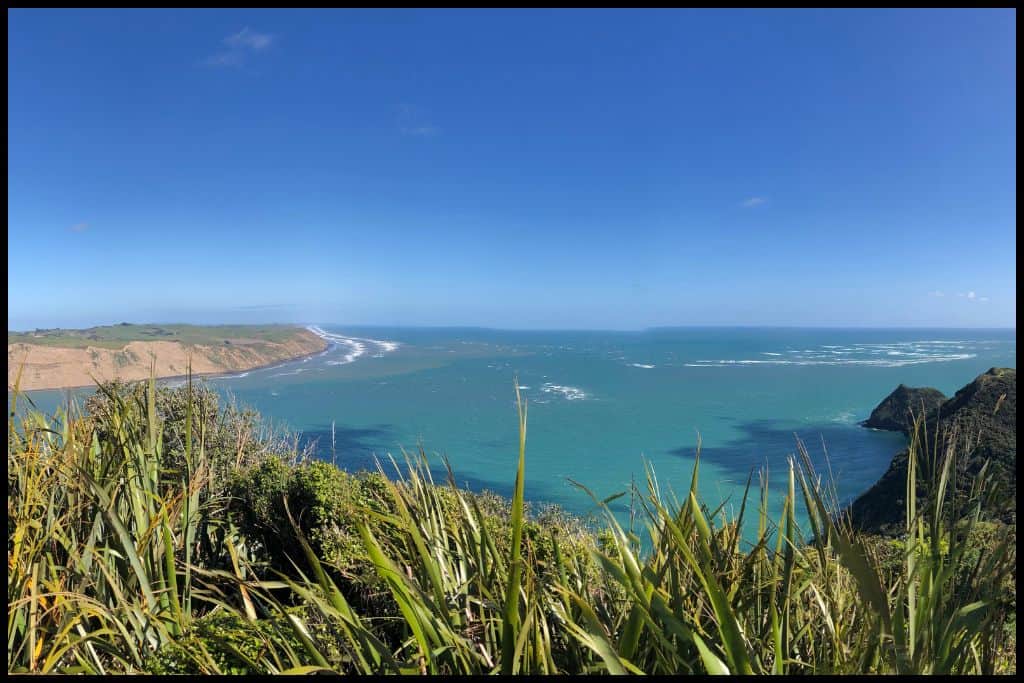
Don’t swim at the beach, as it isn’t patrolled and it is just not worth the risk of being swept out.

9. Kariotahi
Kariotahi is south of all of the Waitākere Ranges Regional Park beaches listed above: it lies on the Āwhitu Peninsula, which means you’ll access it from a completely different part of Auckland. As the crow flies, it is only a couple of kilometres across the water – (the Mānukau Bar) – between Whātipu and Kariotahi, but whereas you’ll need to drive out into West Auckland to access the Waitākere Ranges, for the Āwhitu Peninsula, you’ll need to come all the way out south, and then southwest to the township of Waiuku (and further still).
It’s a good one for swimming, as it is lifeguarded in the summer.
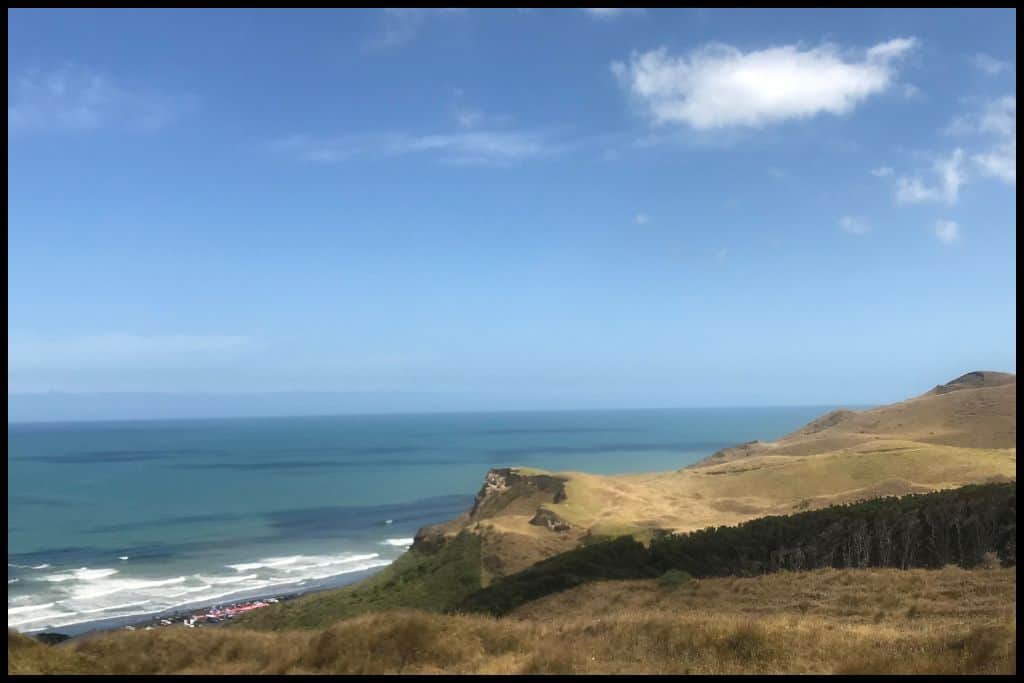
If you visit in the winter, however, you might be happier soaking in one of the warm milk baths that the nearby Castaways Resort offers (would recommend!).
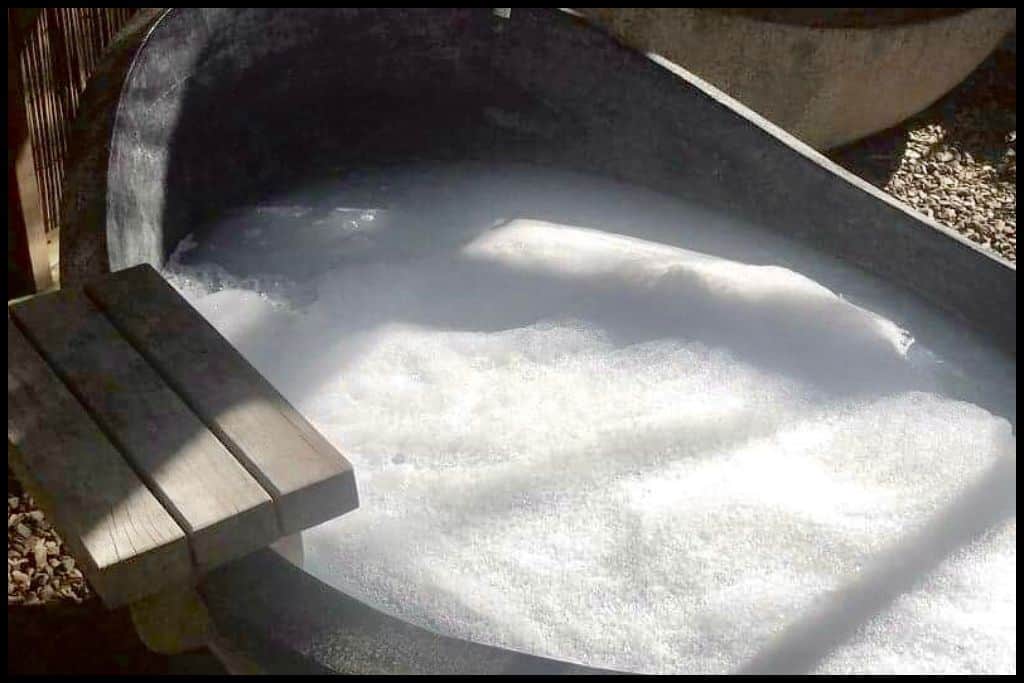

Black Sand Beaches in the Waikāto:
Heading south out of the Auckland Region will lead you into the Waikāto, and once again, it’s down the western coastline where you’ll find the black sand beaches.
10. Ngārunui (Ocean Beach)
You’ll find Ngārunui (or Ocean Beach, or Main Beach) in Raglan, a coastal township which attracts surfers to its mighty waves. This is a great place to learn to surf, and the surf school operates from here. More experienced surfers will love the neighbouring beaches as well, but Ngārunui suits beginners the best.

Above the beach is Wainui Reserve, a 140 hectare park boasting great walking trails and beautiful views of the black sand beach.
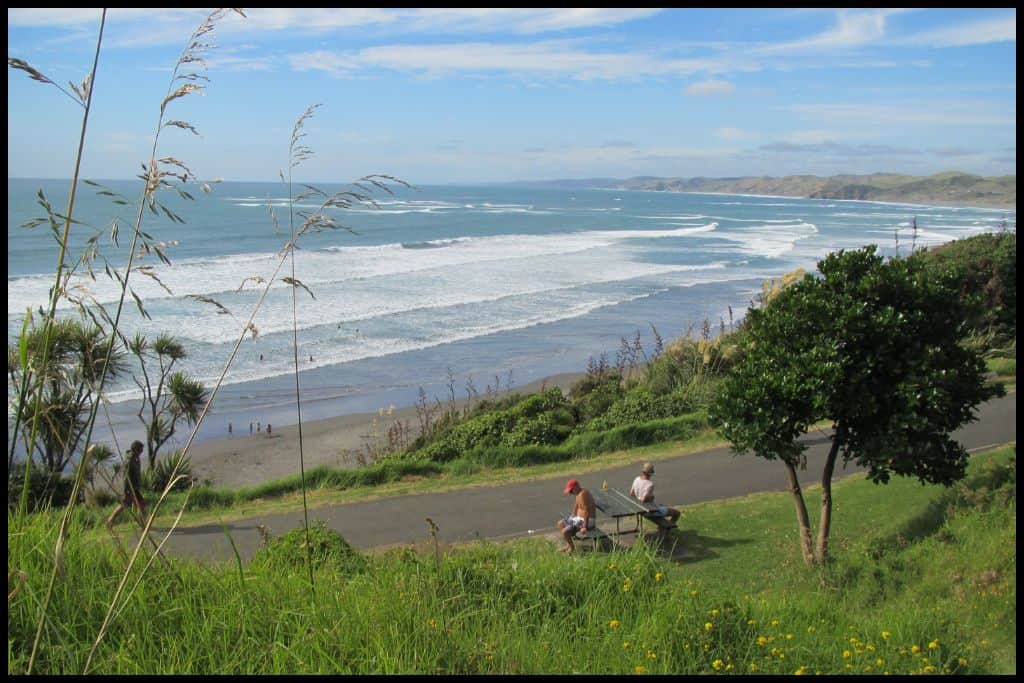
11. Kāwhia (Hot Water Beach)
This beach is extra special! Not only is it a black sand beach, but it is a geothermal, hot-water black sand beach! (Not to be confused with the more famous Hot Water Beach on the Coromandel Peninsula).
You’ll want to visit either 2 hours before low tide, 2 hours after low tide, or in between those times, as the tide needs to be out for you to be able to to dig into the sand and create your own little hot pool. Bring a spade, dig into the black sand, and enjoy the sun setting over the horizon in the west (now that’s something that you can’t do at the other hot water beach, which faces the east).
Black Sand Beaches in Tāranaki:
Tāranaki Region wraps around Mt Tāranaki – the perfect cone of a mountain, sitting bang in the middle of a perfectly rounded, 263 kilometre (163 mile) coastline (the Tāranaki Bight). Along that coastline, you’ll find three black sand beaches well worth visiting:
12. Back Beach
Surfers will love Back Beach – and swimmers too. Walking along the black sand can be hot in summer, so wear open shoes.
If you walk to the end of the beach, you can spot the Sugar Loaf Islands and Paritutu Rock (which is a 30 minute scramble to the top). The five islands are all you can see above the surface of what used to be a volcanic crater. (There is a lot more going on geologically, under the waves and it is worth the plunge, if you’re a diver!) It’s the volcanic activity that has caused the black sand, which glitters in the sun and truly looks magnificent.
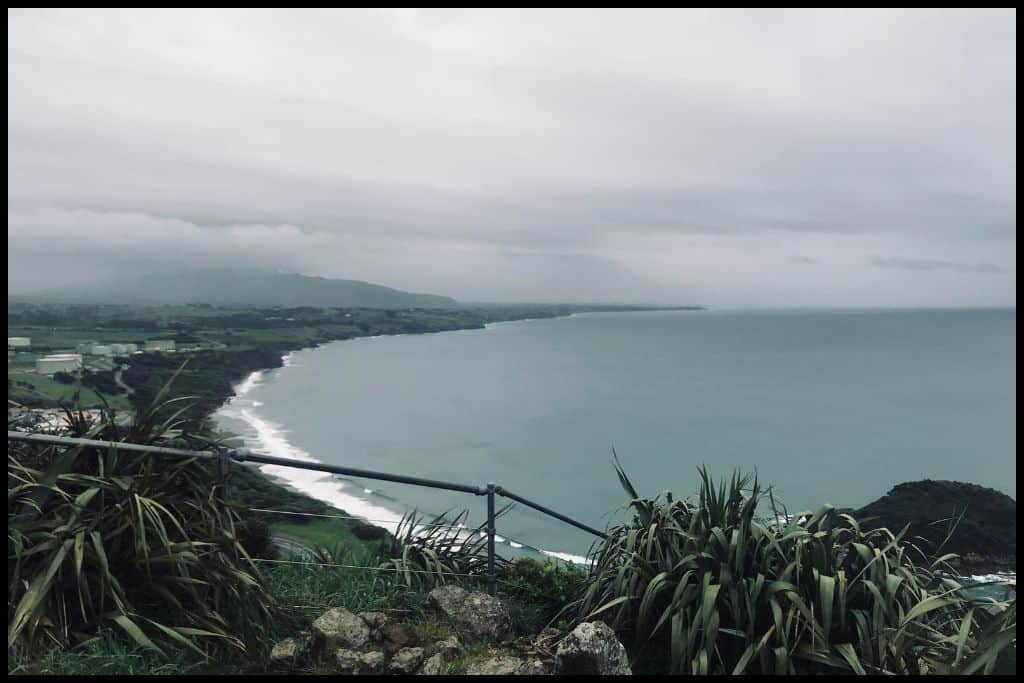
There’s a big sand dune good for boarding down, and if you come at low tide, you might spot some sea lions between the beach and the islands.

13. Waikawau (Tunnel Beach)
Waikawau is an isolated black sand beach halfway between Hamilton in the Waikāto and New Plymouth in Tāranaki, (so it might also come up as a beach in Te Kuiti, when you search, which is the nearest town!) It’s isolated because not a lot of this stretch of coastline is accessible to the public, but this black sand wonder is.
The cool part about this beach is that you have to walk through a tunnel, which has been dug through the cliff, to access it! It’s best to visit at low tide.
14. Tongapōrutu (Three Sisters Beach)
This black sand beach is north of New Plymouth, and on your drive in, if you’re coming in from the north. It’s known as Three Sisters Beach because of the two (and previously, three) rock formations that stand upright out of the water.
It’s also home to Elephant Rock, which really does look like an elephant from the right angle (although the part that looked like the elephant’s trunk has now eroded away). Again, this black sand beach is best visited at low tide, when you can get right down there amongst it, see the sisters up close, and explore the caves that are on the beach.
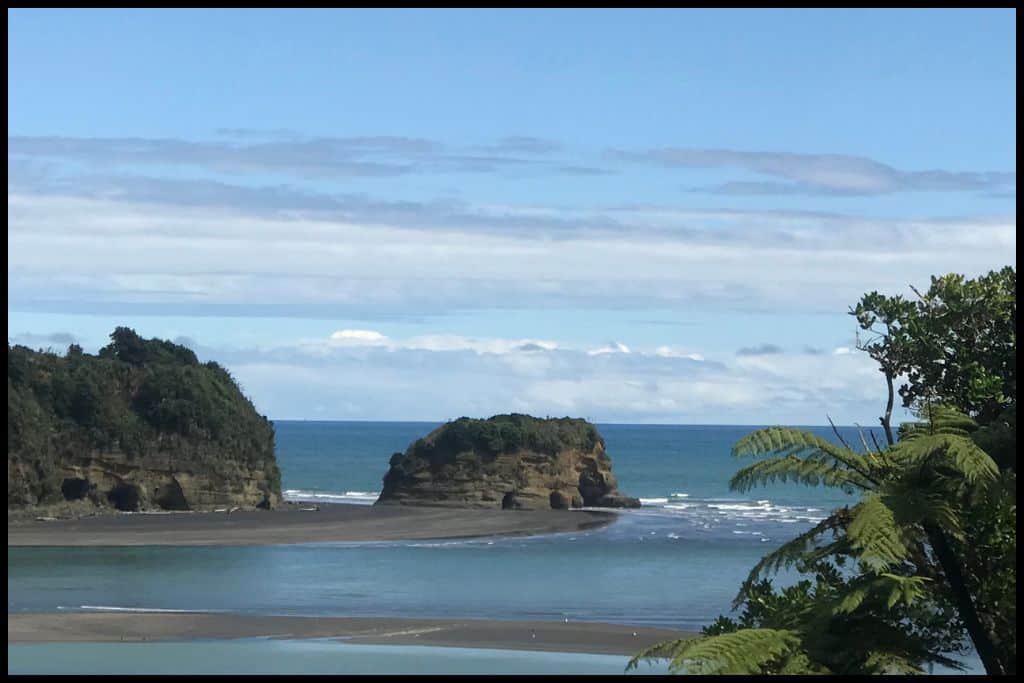

Black Sand Beaches in Canterbury:
Yes, there are even black sand beaches in Canterbury! The black sand comes from titanomegnetite, which comprises titanium and iron, deposited on the coastline by volcanic activity a long time ago. These black sand beaches listed below are found on the east coast of the South Island.
Frequently you’ll find the black sand is more of a black gravel, but it, too, has been deposited there by historic volcanic activity.
15. Tumbledown Bay
Tumbledown Bay, an 80 minute drive from Christchurch, is a black sand beach that is a bit of a hidden gem. It’s on the southern side of Banks Peninsula and a good spot for a swim or paddle. It’s a safe beach and a good spot for families. You’ll need to drive 20 minutes down a dirt road to get here, but Canterbury locals love it there – and you might even spot a seal!
16. Te Oka Bay
Te Oka Bay is also close to Christchurch (it’s the next one over from Tumbledown Bay, just 2 kilometres (1.2 miles) away, so it is a similarly beautiful landscape, with its green headlands and black sand beach. It’s a small beach, and only a dirt road connects them).
You can choose to walk down via the Te Oka Reserve Track, which is 6 kilometres (3.7 miles) and will take you an hour and a half (but bear in mind that what goes down, must come up!)
17. Sumner Beach (Cave Rock)
Sumner Beach is just a 20 minute drive (12 kilometres, 7.5 miles) out of Christchurch CBD, in the suburb of Sumner. It’s family friendly, swimmable, and lifeguarded. A main feature is Cave Rock, which lies on the beach and has a memorial at the top. Children will love climbing the rock and playing in the cave.

18. Black Pebble Beach
Black Pebble Beach is one of a few in North Canterbury that all have black gravel instead of black sand. Swimmers do need to be wary of the steep drop-off from these beaches and not go out too far, as well as stay mindful of strong undercurrents and any rips.
This particular black sand beach (well, black pebble beach), is a 50 minute drive north of Kaikōura, and in the background, you’ll see the alps, normally capped with snow! It’s beautiful, it’s wild, and you’ll probably spot a seal or two.

19. Taylor’s Mistake (Te Onepoto)
Not too far from Christchurch, Taylor’s Mistake (or Te Onepoto in Māori) is a rugged and wild beach with black sand, tall cliffs, and great surfing. Taylor’s Mistake is sometimes patrolled by lifeguards, so time your trip with their patrol, if swimming is on your agenda.
If it is not, take a walk up the Taylor’s Mistake Track, part of the Godley Head Track (the whole area is part of the Godley Head Farm Park Reserve). The Taylor’s Mistake Track is uphill for 1 hour (one-way), and then comes back down to the beach (or you can walk into Sumner, via the Flower Track). The highest point will afford you stunning views of the black sand beach below.
Black Sand Beaches on the East Cape:
The East Cape is the most eastern part of the North Island, and runs from Whakatāne in the Bay of Plenty Region, right around to Hastings, in the Hawkes Bay Region. Most renowned for its black sand here is Blacks Beach:
20. Blacks Beach
Blacks Beach is the most known black sand beach in the East Cape area. It is closest to the town of Māhia and the Māhia Peninsula, just over an hour south of Gisborne. It has black sand dunes and makes for a pretty walking spot, surfing spot (with both left and right hand breaks), or fishing spot (there’s such a range of fish to be caught here!). There is a lookout which will provide views of the Māhia Peninsula and a track to nearby Waitaniwha Bay, where the waves cause a natural blowhole to occur.
Black Sand Beaches on the West Coast:
Generally when New Zealander’s refer to ‘The West Coast’ (without further specifying), they actually mean the west coast of the South Island, which runs right from Karamea in the top left of the South Island, and the Kahurangi National Park, right down past Haast and the coastal parts of Mount Aspiring National Park.
Down this stretch, you’ll find a couple of black sand beaches: Hokitika Beach in Hokitika, Rapahoe Beach near Greymouth, and in the beaches near Westport, you will find just a strip of black sand down otherwise lighter-sand beaches. It’s rich in iron and titanium, like all the beaches above, and it comes from the Southern Alps down the rivers that run out to the coast, but it’s not as concentrated as a fully black sand beach would be, in the North Island.
21. Hokitika Beach
Hokitika Beach is a black sand beach, right there in the town of Hokitika, so it is easy to access and well worth grabbing some fish and chips before heading down to eat them on the shore. It has both black sand and pebbles, and lots of driftwood – some of it has been used to spell out ‘Hokitika’ – an iconic creative piece that stands on the beach. Swimming is not advised here as it is so rough but surfers will really enjoy this black sand beach!

Frequently Asked Questions About Black Sand Beaches in New Zealand
Still undecided on where to go? Here are some frequently asked questions about black sand beaches in New Zealand.
Which Are The Best Black Sand Beaches for Surfing?
Many of these black sand beaches are fantastic for surfing. Ngārunui (Ocean Beach) in Raglan, is especially good because it caters to all levels and has both left and right peaks. Raglan is known for its surfing and would be one of the best spots in the whole country, because it doesn’t get hit with south-west winds that can affect the surfing on other west coast beaches.
Of the Waitākere Ranges beaches, Piha is the most sheltered black sand beach and has consistently good surf. There is a surf school there (and also at Karekare, Te Henga and Muriwai).
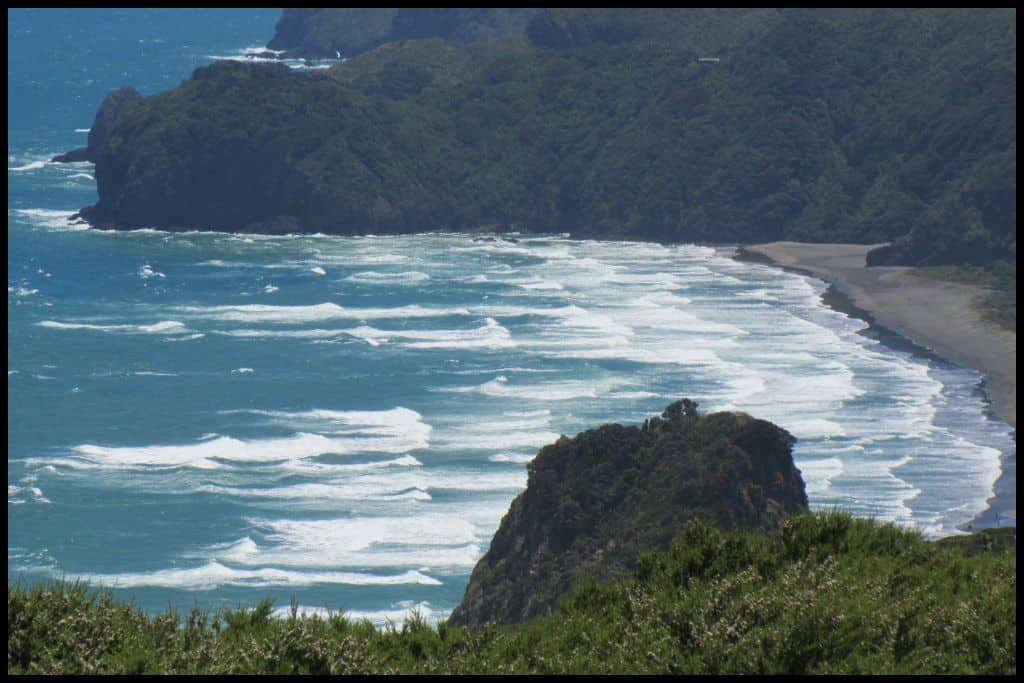
Why Is There Black Sand On The West Coast Of New Zealand?
Sand is made up of mineral particles – crashing waves break up rock over and over, and sand gets finer and finer, the older it is. Black sand is made up of particles from volcanic rock (like lava and basalt).
The black sand on the west coast of the North Island is made of titanomagnetite – titanium and iron – and it originates from Mount Tāranaki, 2.5 million years ago. It has been swept all the way up the west coast, which is why we find it in Raglan, and then further north on the Āwhitu Peninsula, and further north again on the Waitākere Ranges beaches.
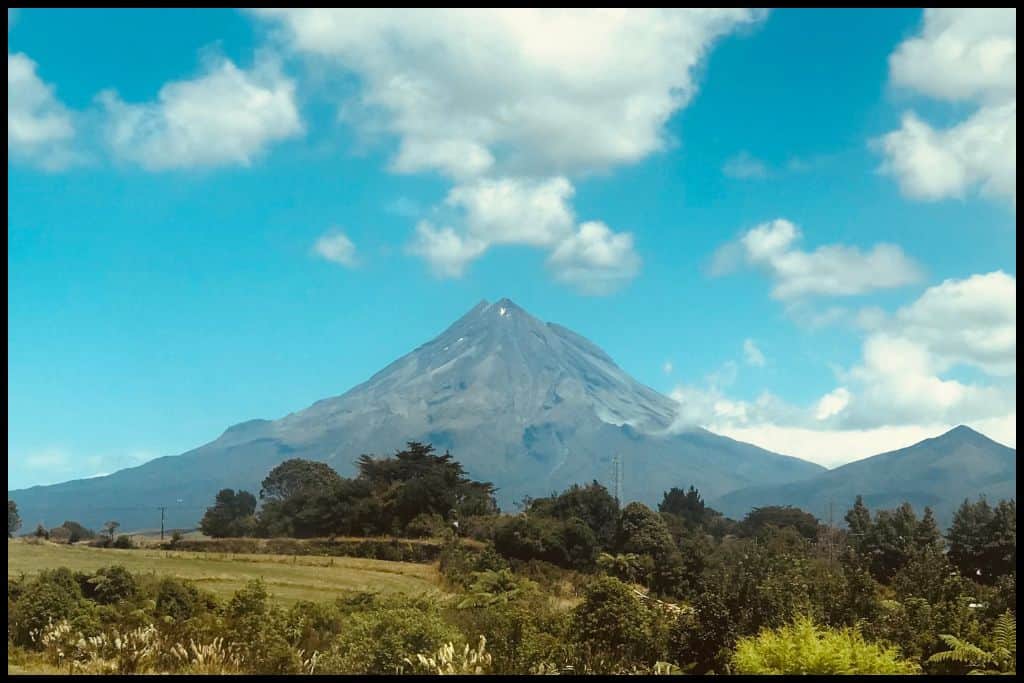
Is Black Sand Full Of Iron?
Yes! The titanomegnetite is what makes it black, and that is a combination of titanium and iron. Because black sand is rich in magnesium and titanomagnetite, just walking on a black sand beach can help us with stress and our circulation!
The ironsand (as it is also called) has even been mined to make steel at the steel mills, which the west coast of the North Island has a history of.

Frequently Asked Questions About Piha
Piha is the most known of all the black sand beaches in New Zealand, and possibly the first one you heard about, too! So, below, I have answered some of the main questions that you might have about this wild black sand beach:

Can You Swim At Piha Beach?
Yes! Piha is patrolled by lifeguards on weekends and public holidays from approximately Labour Weekend (end of October) until Easter (mid April), from 11am until 5pm. This increases over the summer break (end of November until the end of March) when they also cover weekdays, start at 10am, and finish at 6pm.
Always check the Piha Surf Life Saving Club Page and don’t go in if there isn’t a patrol on! Most of the drownings that occur at Piha are when the lifeguards are not patrolling.

Is Piha Beach Free To Visit?
Yes! Piha is free to visit. Piha Surf Life Saving Club is made up of volunteer lifeguards, and being at the beach itself is, of course, free. Parking is free as well.
How Busy Is Piha Beach?
Piha can be quite busy on a summer’s day – about 1,000 people live there, and many Aucklanders will flock there for a swim on a day trip. You’ll still be able to find a spot on the sand, however, and probably a good couple of square metres to yourself, at least. For a visual, do a quick Youtube search of Piha Rescue, the television show that will show you exactly how busy to expect Piha in the height of the season.
Is Muriwai Or Piha Better?
This is a hard one!
Muriwai has the benefit of being perhaps a little less crowded, a gannet colony that you can walk up and see, and a blowhole.
However, Piha has a couple of lookout walks, is closer to Auckland City and therefore a slightly quicker drive there, and proximity to Kitekite Falls.
I would probably rate Piha higher, as if you find yourself amongst too many people on South Piha Beach, you can walk over to North Piha Beach where there aren’t as many people (it’s typically dog walkers and surfers). Plus, the Falls are an alternative again if the surf is too rough for you (or the black sand is too hot!)
How Do You Get To Piha Without A Car?
Driving is definitely the easiest way to get to Piha, but if renting a car, taking an Uber, or catching a lift is not an option for you, you’ll have to get creative! No public transport options will get you all the way there.
My advice would be to jump on Viator or Trip Advisor and find a day trip from option that will take a tour group from Auckland City. Your transport will be all sorted, and you will be free to enjoy the beach without worrying how you will get back!
It doesn’t take much to see how beautiful New Zealand black sand beaches are. Their very existence acknowledges how much our country’s beauty owes to all the volcanic activity that was occurring before we were here, and sets these beaches apart as a little bit uncommon, a little bit special, and worth experiencing for yourself. Which one will you visit next?
